Having evergreen plants in your gardens or around the house can really make a big difference. Most of these plants are hardy breeds that can retain their leaves and texture all year round, through changes in seasons and weather. This is why gardeners love to use evergreen shrubs to create boundaries, topiaries, formal hedges, and other elements in landscaping.
Evergreens can also be fast-growing and easier to maintain. Simply put, the numerous benefits that you get when planting evergreen plants makes them a great choice no matter where you live.
But did you know that you can also cultivate evergreen plants in hanging baskets? That’s right. Undoubtedly, these plants can be a great addition to your hanging garden design.
In this article, we have laid out some of the best evergreen plants that you can choose to be grown in hanging baskets. Some produce vibrant and beautiful flowers while others will mesmerize you with their unique green foliage.
Table of Contents
1. Abelia (Abelia)

Abelia is a genus of shrubs with almost 30 species and hybrids. They can be deciduous or evergreen depending on which growing zone you are growing them in.
These hardy plants are native to eastern Asia and southern North America, specifically in Japan and Mexico. They can grow up to 10 feet tall with a spread between 2 and 8 feet wide. Take note of the size of the cultivar you use in your containers so you can keep it trimmed, else it may take over with its fast growth rate.
Abelias can be recognized by their sharply oval, glossy leaves that come in yellow, orange, green, bronze, and burgundy.
These plants also produce white tubular flowers that change color according to the seasons. Abelias can tolerate full sun or partial and prefer to live in moist, well-drained soil. Pollinators such as butterflies and hummingbirds are attracted to the sweet fragrance of Abelia’s flowers.
2. Verbena (Verbena)

Also known as vervain or verveine, these herbaceous evergreen plants are native to the Americas, Asia, and Europe. There are more than 250 species of Verbena but the most common three varieties that you can find are hybrid verbenas, trailing verbenas, and semi-trailing verbenas.
Depending on their varieties, verbenas grow between 6 and 12 inches (for trailing varieties) or up to 10 feet tall (for shrub Verbenas). They produce small, five-petaled flowers that come in pink, purple, white, and blue.
These plants thrive under full sun and grow healthily in moist, well-drained soil. Most verbena flowers produce sweet scents that will attract bees, butterflies, hummingbirds, and other pollinators.
3. Cyclamen (Cyclamen)
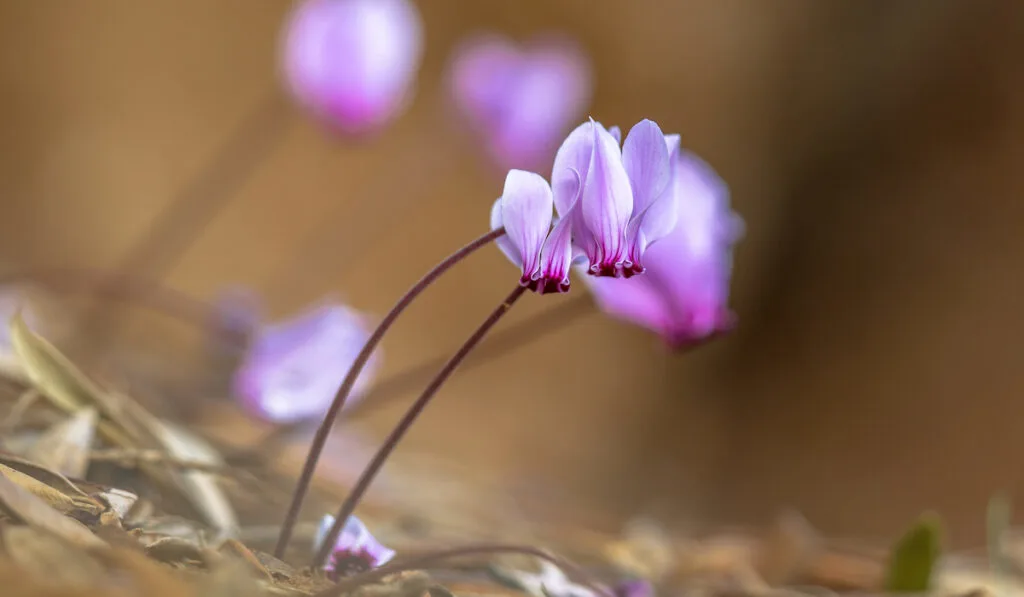
Cyclamens hail from the alpine forests of western Asia, southern Europe, and North Africa close to the Mediterranean. They are also called the “Florist Cyclamen” or indoor cyclamen. These plants also come in tender and hardy varieties with more than 23 different species.
Cyclamens generally grow between 6 and 9 inches tall with similar spreads. They can be recognized by their heart-shaped foliage marked with white or silver markings and five, twisted-petaled flowers that come in white, pink, red, and violet. These plants should be cultivated in moist, well-drained soil in partial sun or shade.
Most Cyclamen varieties are toxic to humans and animals. So, be sure not to ingest any part of these plants and place them away from your pets.
4. Rhododendron (Rhododendron)
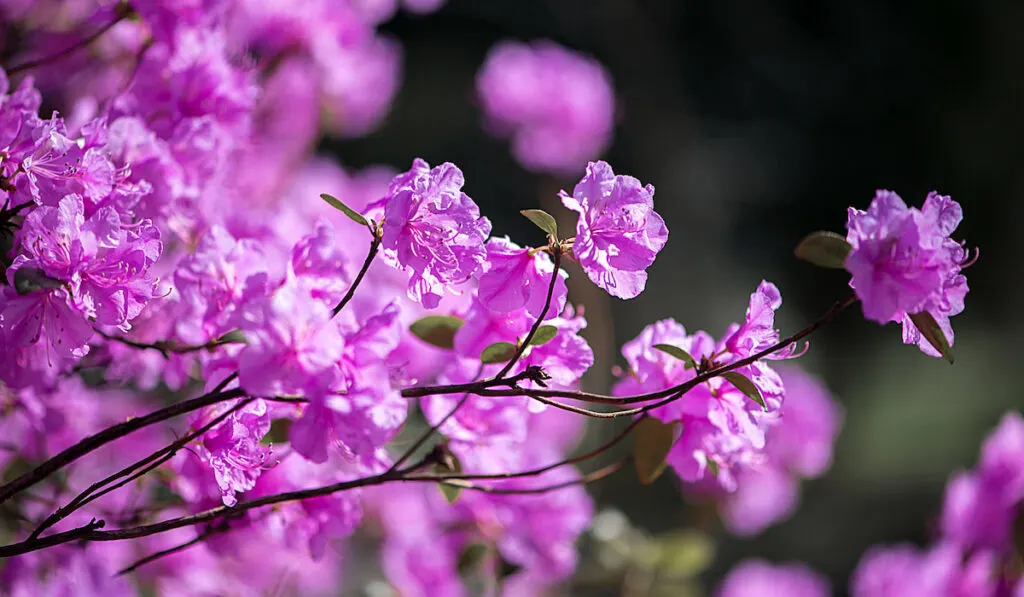
These evergreen shrubs are native to the land of the Himalayas, the mountains of New Guinea in Southeast Asia, and the eastern woodlands of the United States.
Rhododendrons often grow alongside another species within their genus, the azalea, and another evergreen, the mountain laurel. They grow between 8 and 20 feet tall with a spread that can reach as wide as 25 feet.
These plants provide nectar and pollen to many insects such as bumblebees, butterflies, and hummingbirds.
Rhododendrons can be recognized by their green, leathery leaves and scented, bell-shaped flowers that come in white, pink, red, orange, yellow, and purple. They can tolerate partial or full sun and thrive in moist, slightly acidic, and well-drained soil.
Because of their ultimate size, only very young plants will work in containers and baskets.
5. Mountain Laurel (Kalmia latifolia)
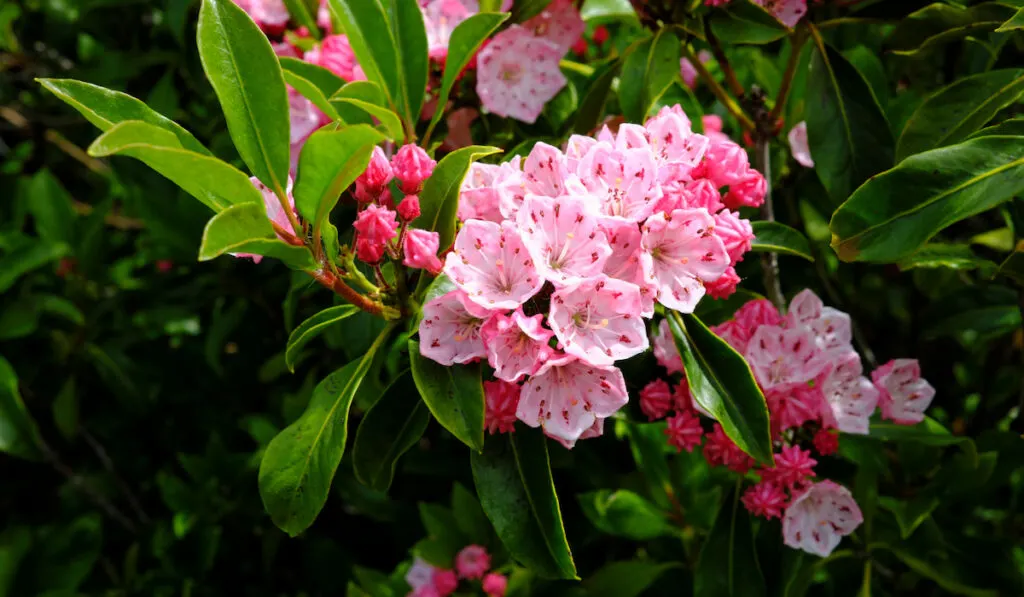
Also known as spoonwood, ivy bush, American laurel, and calico-bush, mountain laurels are native to the eastern United States, particularly from southern Maine south to northern Florida, and west to Indiana and Louisiana. They are crowned as the state flower of Pennsylvania and Connecticut.
These dense, evergreen shrubs can grow between 6 and 10 feet tall with similar spreads. There are dwarf cultivars that only grow up to 3 feet tall. The leaves of mountain laurels are generally green and broad with trumpet-shaped flowers that come in pink, white, and red.
These plants require a slightly acidic, well-drained soil in partial sun. Being slow growers, mountain laurels generally only grow between 1 and 2 feet per year.
6. Common Juniper (Juniperus communis)
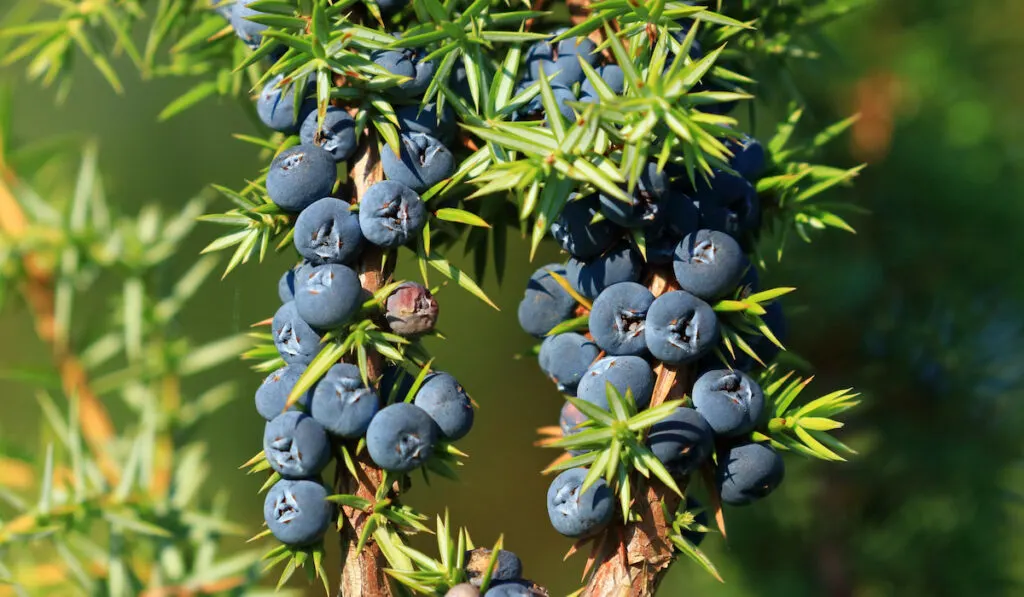
Common junipers are considered one of the most widely distributed plants in the world. These evergreen coniferous shrubs are native to Europe, North America, Asia, and Africa.
They generally grow between 2 and 5 feet tall with a spread between 7 and 13 feet wide. Large cultivars can reach up to 50 feet high and they mostly grow in the forests.
Common junipers can be characterized by their green, needle-shaped, and prickly leaves with berry-like cones. These seed cones are known as “juniper berries” which resemble blue and round berries.
Aside from being eaten by game birds, the cones can also be processed into meat seasonings and flavorings for gin. These plants thrive in well-drained soil and under full sun. The trailing varieties can provide interest in containers year-round.
7. Bacopa (Bacopa sp.)
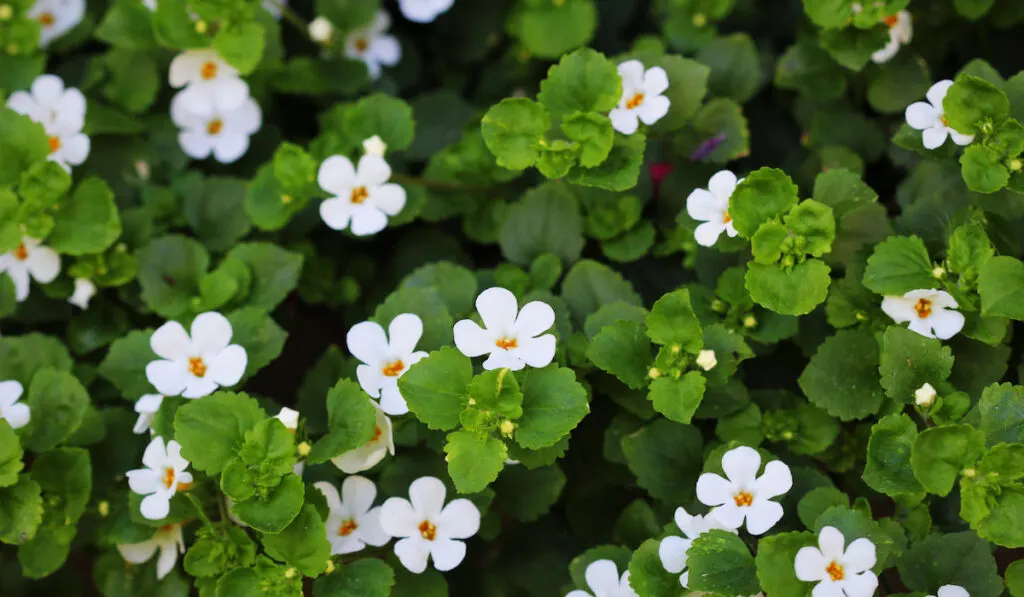
These creeping, herbaceous plants can be commonly found in the wetlands of eastern and southern India, Asia, Australia, North and South America, Europe, and Africa. Bacopas are also known as water hyssop, Indian pennywort, Brahmi, and herb of grace. They generally grow between 3 and 5 inches tall with a spread around 12 inches wide.
These plants will produce numerous five-petaled flowers from May to October. These small flowers come in white, pink, blue, red, and lavender. Bacopas thrive prolifically under partial sun and in moist, well-drained soil. They will only be evergreen in warmer climates and are treated as annuals in more northern areas.
8. Lobelia (Lobelia)

Lobelias are native to southern Africa. They are also called “Indian Tobacco” and are considered excellent filler plants that are easy to grow. There are more than 400 species of these shrubs ranging from hardy, tender, evergreen, and perennial, to aquatic and mounding types.
Lobelias generally grow between 10 and 12 inches tall and larger species can reach up to 4 feet tall. They have yellowish or pale-green leaves with tiny flowers that come in white, pink, red, and violet.
These plants thrive in a moist, well-drained, and under full sun. During the hot season, it is best for you to place Lobelias under partial shade and regularly water them to keep the soil wet.
9. Heuchera (Heuchera)
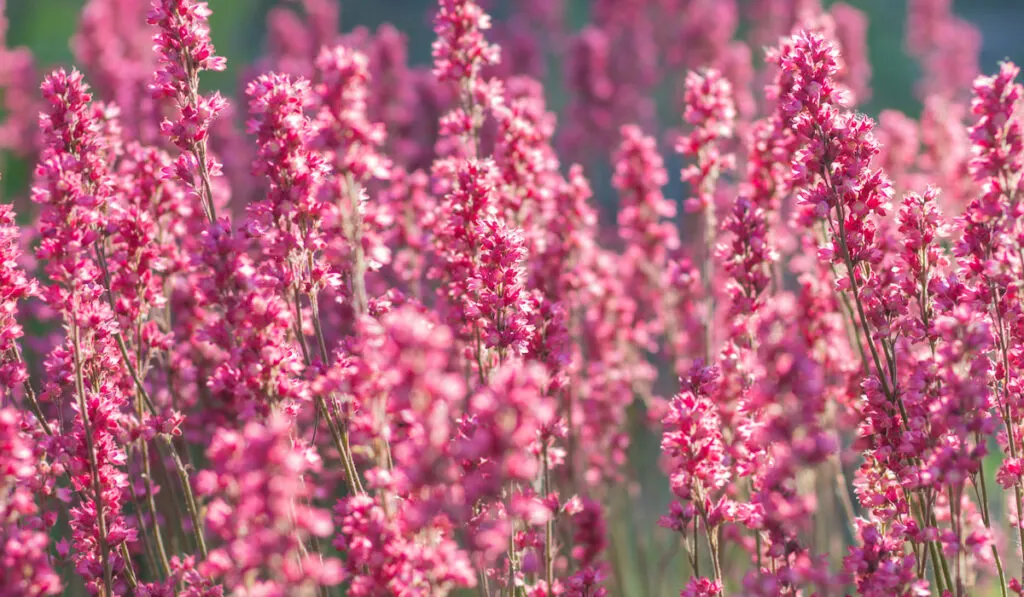
Also known as coral bells or alum root, these perennial plants are native to North America. Heucheras are herbaceous, shade-loving plants that can easily grow in hanging baskets, containers, and garden beds. They generally grow 6 to 18 inches tall with a spread of 12 to 36 inches wide.
These mounding plants are easily recognized by their large foliage that comes in green, brown, purple, lime, burgundy, and red. They also have distinctive bell-shaped flowers that grow on a long stalk just above the foliage.
The variety of foliage colors makes them the perfect season-long accent plants in almost any situation.
Heucheras grow prolifically in moist, well-drained soil and under full sun. But they can also tolerate partial shade, especially during the hot season.
10. Sweet Alyssum (Lobularia maritima)
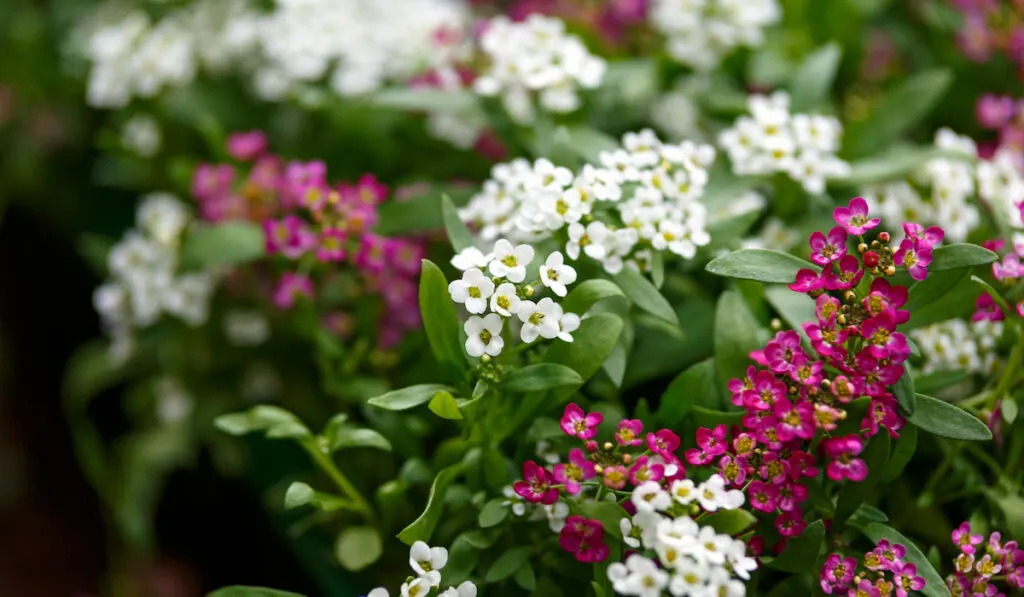
Sweet alyssums are native to Europe and the Mediterranean and are considered invasive plants in the United States, particularly in California. With their sprawling habit, these plants can grow 4 to 10 inches tall with a spread of 10 to 48 inches wide.
From the spring until early winter, they will produce tiny, honey-scented flowers that come in white, purple, lavender, rose, and apricot.
Although sweet alyssums are hardy and possess the ability to tolerate drought and extreme heat, they still need to be cultivated in moist, well-drained soil. They can also tolerate partial shade but prefer to stay under direct sunlight for at least 6 hours.
11. Ivy Geranium (Pelargonium peltatum)

These trailing ornamental plants are native to southern and eastern Africa. They are also known as cascading geranium and ivy-leaved pelargonium and are available in 75 cultivars. Ivy geraniums generally grow 1 to 3 feet tall with a similar spread. They can be recognized by their bright green, five-lobed foliage and five-petaled flowers that bloom heavily from May to October.
These flowers come in white, pink, purple, red, orange, apricot, lavender, and burgundy. Ivy geraniums grow healthily in slightly acidic, moist, and well-drained soil. Although they can tolerate direct sunlight, it is best for you to place them under partial shade, especially when the weather is too hot.
Aside from regular watering and deadheading, these plants are easy to maintain.
12. Begonia (Begonia)
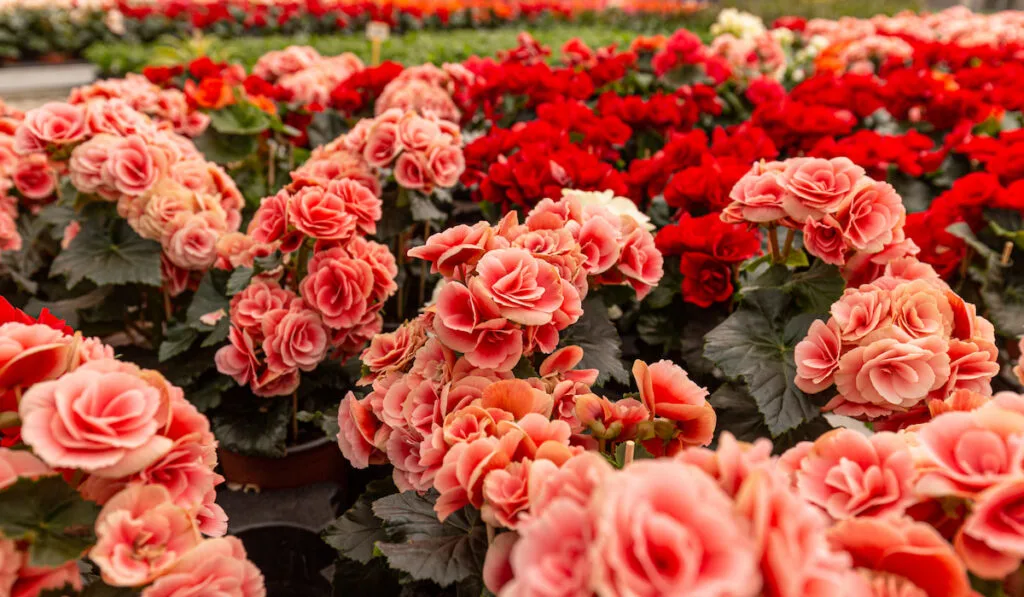
Begonias are an evergreen species in some places and tender annuals in others. They are ideal for cultivation in containers or hanging baskets. They can be found in many parts of the world, particularly in moist tropical and subtropical climates. There are more than 2,000 species of Begonias that are categorized based on the structure of the roots.
These include tuberous begonias, rex begonias, rhizomatous begonias, hardy begonias, and fibrous-rooted begonias. Depending on the varieties, they grow 1 to 3 feet tall. Some larger varieties can even reach up to 8 feet tall.
Begonias are easy to maintain and can be kept both indoors and outdoors. They thrive in moist, well-drained soil and under partial sun.
13. Gardenia (Gardenia jasminoides)
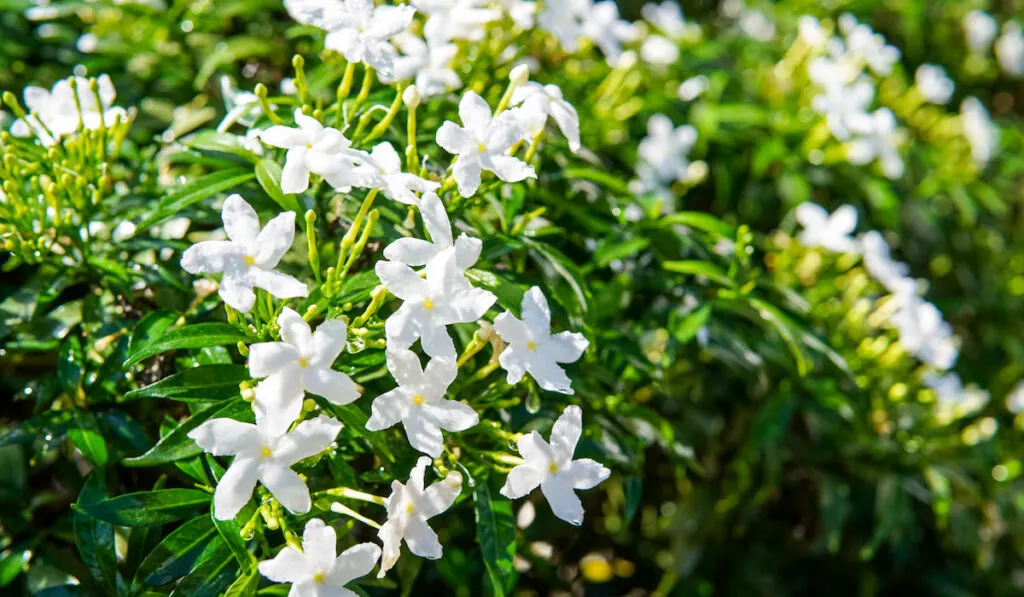
Also known as the Cape Jasmine, these evergreen shrubs are native to tropical regions of East Asia such as Taiwan and China, Australia, Africa, Japan, and the Pacific Islands. They are named after a Scottish physician and botanist, Alexander Garden, who lived in Charleston, South Carolina. Gardenias generally grow 3 to 8 feet high with a similar spread.
They have scented white flowers that bloom in the spring, summer, and fall. These flowers are toxic to animals and should be kept away from pets. Gardenias are exquisite plants that produce a remarkable and unique scent.
They thrive under partial sun and in moist, acidic, and well-drained soil. Although they are high maintenance, these plants will make a great addition to your hanging baskets due to their fragrance and texture.
Final Thoughts
Although the above plants are easier to care for, they still need to be watered frequently, fertilized from time to time, and exposed to a sufficient amount of sunlight. Larger varieties kept in hanging baskets or other containers may need pruning through the season to keep them in control.
Evergreen plants are often used as accent plants and fillers in containers and baskets because of their long-lived leaves.
No matter which species you choose, don’t forget to trim any dried flowers or leaves to keep them looking fresh and appealing.
Resources
- https://www.countryliving.com/gardening/garden-ideas/g25367864/best-evergreen-shrubs/
- https://www.gardendesign.com/shrubs/evergreen.html
- https://anythinggoeslifestyle.co.uk/year-round-hanging-baskets/
- https://www.masterclass.com/articles/abelia-plant-guide#what-is-an-abelia-plant
- https://www.gardendesign.com/annuals/verbena.html
- https://www.thespruce.com/how-to-care-for-cyclamen-1402644
- https://www.bhg.com/gardening/plant-dictionary/shrub/rhododendron/
- https://www.thespruce.com/mountain-laurel-plants-growing-tips-2131174
- https://gobotany.nativeplanttrust.org/species/juniperus/communis/
- https://www.birdsandblooms.com/gardening/flower-gardening/best-container-plants-bacopa/
- https://www.gardendesign.com/flowers/gardenia.html
- https://www.apartmenttherapy.com/begonia-plants-262335
- https://www.hgtv.com/outdoors/flowers-and-plants/flowers/ivy-geranium
- https://www.gardeningknowhow.com/ornamental/flowers/lobelia/lobelia.htm
- https://www.hgtv.com/outdoors/flowers-and-plants/planting-heuchera
- https://www.gardendesign.com/annuals/alyssum.html
